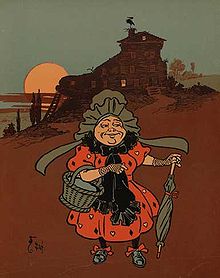Nursery Rhyme With Put the Shoe Together Again
| "At that place Was an Old Woman Who Lived in a Shoe" | |
|---|---|
 Illustration by West. Westward. Denslow, from a 1901 edition of Mother Goose | |
| Nursery rhyme | |
| Published | 1794 |
| Songwriter(due south) | Unknown |
"There was an Old Woman Who Lived in a Shoe" is a pop English linguistic communication nursery rhyme, with a Roud Folk Song Alphabetize number of 19132. Debates over its pregnant and origin have largely centered on attempts to match the old adult female with historical female figures who accept had big families, although King George II (1683–1760) has also been proposed every bit the rhyme's field of study.
Lyrics [edit]
The about common version of the rhyme is:[one]
There was an erstwhile adult female who lived in a shoe.
She had so many children, she didn't know what to do.
She gave them some broth without any bread;
Then whipped them all soundly and put them to bed.
The earliest printed version in Joseph Ritson's Gammer Gurton'due south Garland in 1794 has the coarser concluding line:
She whipp'd all their bums, and sent them to bed.[2]
Many other variations were printed in the 18th and 19th centuries.[ane] Marjorie Ainsworth Decker published a Christian version of the rhyme in her The Christian Mother Goose Book published in 1978:
There was an old woman
Who lived in a shoe,
She had so many children,
And loved them all, also.
She said, "Thank you Lord Jesus,
For sending them breadstuff."
So kissed them all gladly
and sent them to bed.
Origins and meaning [edit]

Iona and Peter Opie pointed to the version published in Infant Institutes in 1797, which finished with the lines:
Then out went thursday' old woman to bespeak 'em a bury,
And when she came dorsum, she found 'em all a-loffeing.[1]
The term "a-loffeing", they believe, was Shakespearean, suggesting that the rhyme is considerably older than the first printed versions. They then speculated that if this were true, information technology might have a folklore meaning and pointed to the connexion between shoes and fertility, perhaps exemplified by casting a shoe after a bride as she leaves for her honeymoon,[iii] or tying shoes to the parting couple'southward motorcar.[4] Archaeologist Ralph Merifield has pointed out that in Lancashire it was the custom for females who wished to excogitate to endeavour on the shoes of a adult female who had only given birth.[v]
Debates over the pregnant of the rhyme have largely revolved around matching the quondam woman with historical figures, as Peter Opie observed "for piddling reason other than the size of their families". Candidates include Queen Caroline, the married woman of King George 2 (1683–1760), who had eight children, and Elizabeth Vergoose of Boston, who had six children of her own and ten stepchildren.[1] Some show suggests the rhyme refers to the wife of Feodor Vassilyev of Shuya, Russia, who reportedly birthed 69 children during her lifetime (1707–c.1782).[ commendation needed ]
Albert Jack has proposed a political origin for the rhyme. George II was nicknamed the "old woman", because it was widely believed that Queen Caroline was the real power behind the throne.[a] According to this caption, the children are the Members of Parliament (MPs) that George was unable to control, the whip refers to the political office of that name – the MP whose role is to ensure that members of his party vote co-ordinate to the party line – and the bed is the House of Commons, which MPs were required to attend daily. The phrase "gave them some broth without whatever bread" may refer to George'southward parsimony in the wake of the South Ocean Bubble of 1721, and his attempts to restore his ain and the country'southward finances.[iv]
Notes [edit]
- ^ The idea that George Ii was dominated by his queen is expressed in this contemporary verse:[4]
You may strut, dapper George,
But it will exist in vain;
We all know it is Queen Caroline
Non y'all that reign.
References [edit]
- ^ a b c d Opie & Opie (1997), pp. 522–4
- ^ J. Ritson, Gammer Gurton'southward garland, or, The nursery Parnassus: a choice drove of pretty songs and verses for the entertainment of all piffling expert children who can neither read nor run (1794, rpt., Glasgow, 1866), p. 27.
- ^ Opie & Opie (1997), pp. 522–24
- ^ a b c Jack (2008), At that place Was an Old Woman who Lived in a Shoe
- ^ Merridew (1987), p. 134
Sources [edit]
- Jack, Albert (2008), Pop Goes the Weasel: The Hush-hush Meanings of Plant nursery Rhymes (ebook), Penguin, ISBN978-0-14-190930-i
- Merridew, Ralph (1987), The Archaeology of Ritual and Magic, Batsford, ISBN978-0-7134-4870-2
- Opie, I.; Opie, P. (1997), The Oxford Dictionary of Nursery Rhymes (2nd ed.), Oxford University Press, ISBN978-0-nineteen-860088-6
caronfescithavers.blogspot.com
Source: https://en.wikipedia.org/wiki/There_was_an_Old_Woman_Who_Lived_in_a_Shoe
0 Response to "Nursery Rhyme With Put the Shoe Together Again"
Post a Comment